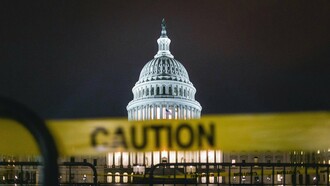India has been home to some of the most significant protests post-2014, the year since the National Democratic Alliance (NDA)-led Government was massively voted to power. What does this mean, and why would I hyphenate the current NDA Government if not for implying some correlation between the rule of the present government and widespread dissatisfaction amongst people?
On the contrary, this big tent alliance clinched a historic majority in the 2014 general elections that any political alliance had not seen since the 1984 election. In the 2019 general election, the alliance further increased its tally by securing 353 seats with a combined vote share of 45.43%. The big-ticket party in the NDA alliance i.e. BJP, garnered 37.4% of the votes in the 2019 general election. In contrast, the Congress party failed to improve its vote share from 2014 and gathered 19.5% of the total votes. Much of the BJP’s rhetoric was salvoed against congress, which had retained power since Independence.
But the popular legitimacy bestowed on the NDA Government does not absolve it of any accountability for its peculiar handling of Protests. At least 5 of the major protests had a stronger resonance amongst the media and on the ground. Much hype had to do with a sense of discomfort caused to those who were not directly involved or didn’t have a shared cause to join the rallying call, while a greater part to solidification and re-fastened realisation of incongruent identities and the consequent divisions amongst people in the country.
Pizzas in return for sit-in at protests
The Citizenship Amendment Act (CAA) and National Register of Citizens (NRC) protest was the first major protest that started in December 2019 and culminated in the February 2020 Delhi Hindu-Muslim riots. Remember that in the last general election (May 2019) the NDA government was voted to power with a thumping majority which almost created a power vacuum in Indian Politics, owing to the devastating performance of all opposition parties. The Indian National Congress, long seen as a champion of Muslims, had lost its appeal. The CAA protest was a one-off event where the Muslim community tried to muster political will on its own. The protest offered a perfect vantage point to solidify and project itself as a standalone force in light of its dwindling faith in INC. After all, what is politics if not about managing public perception?
The CAA/NRC Act already had an abrasive edge. It was feared to instigate anger amongst the Muslim community with its provision to give citizenship to six communities (Hindus, Sikhs, Buddhists, Jains, Parsis and Christians) from predominantly Muslim countries (Pakistan, Afghanistan and Bangladesh) who entered India on or before 31st December 2014. Soon these kinds of gatherings were deliberately confused with an intimidating show of street power in the later protest staged by the community, which ultimately fed and recharged the Hindutva narrative. The protest was met with criticism, some of which suggested that Muslims have held the country hostage by choking parts of the capital city and blatantly threatening to cut off vulnerable areas in the country. Cases of violence and rioting that ensued during the CAA/NRC protests further justified a need to tackle these protestors. And what other legitimate force than keepers of Hindutva is fit and befitting enough to handle the riotous Muslim community? This is a perfect win-win strategy wherein the state apparatus lights the fire in Muslim shanties and dwindles back into the Hindutva citadel only to start a war on the behest of appropriated identities. Bhanu Pratap Mehta calls this strategy a “heads we win, tails you lose strategy.”
"The strategy is this. Say things with impunity about minorities, show your toughness by baiting Islam. Convert tractable political disputes into a whole-scale ideological attack on Islam or Muslims. If you get away with it, you claim credit for showing the strength of Hindus, for a kind of tough bravado. If, on the other hand, there is a reaction of any kind, a push-back, you turn around and claim victim status. If impunity succeeds, you gain power. If impunity fails, you convert that into fodder for a feigned victimhood on which Hindutva thrives.’’1
‘Shaheen Bagh,’ which became a town square for the protest, was talked of as a ‘mini-Pakistan’ that did not entertain the views of non-Muslim people. Efforts to dilute the protest were also made through an oft-employed and perhaps tested strategy of maligning the protestors. Efforts were made to label the women protestors as paid stooges who got $6.50 and food in return for their shift in the protest.
I had noticed a similar strategy being employed to dilute the 2017 protest staged by female students in Banaras Hindu University, situated in the parliamentary constituency of Prime minister Narendra Modi. Although the protest had started with an incident of sexual harassment accusation made by a female student, it had quickly wrapped around issues like hostel curfew timing for women, bad food quality in the women’s mess etc. One of the ways to delegitimise the protest was attempted by floating the narrative that the protest wasn’t an organic outburst but rather a sponsored stunt for which the female students were being fed pizzas.2
The Gurugram protest by members of a few Hindu outfits to the offering of Namaz by Muslims in open space was another example of the souring relationship between the communities. Prayers in public were portrayed as an intimidating move by the Muslim community to flex their muscle and highlight their street power which must be tackled likewise. On both occasions, there was a lack of timely interference by the NDA-led government and, at times, rabid remarks by a leader or two of theirs further aggravated relations between the two communities.
Good protestors and bad protestors
The BJP had also failed to persuade the 2021-2022 farmer protest, which was more or less similar to the CAA/NRC protest in terms of tactics employed. The capital city was sieged, ramparts of the iconic Red Fort vandalised, and several deaths occurred owing to government failure to strike a deal with the agitating farmers. To counter and dilute widespread support, attempts were made to label the protesting farmers as separatists with ‘Khalistan agenda’ seeking to carve a piece away from the Hindu state, andolanjeevi group, sponsored by communist and western forces etc. Attempts were also made to corner the protest as an eruption by farmers from a few select states and not the country as a whole. A similar strategy of dubbing the protest as ‘factional’ is being employed to label the recent protest by students in light of the newly launched ‘Agniveer’ scheme.
In the recent alleged blasphemy case by BJP spokesperson Nupur Sharma against Prophet Muhammad, the BJP sat on the fence, buzzing only at the last moment to damage-control. It appeared defensive after concerns were raised by Islamic Cooperation countries which harmed India’s moral standing. Warrants were issued, houses of rioters indulged in the protest and violence that ensued after Friday prayers in major Indian cities were bulldozed to dust. The nefarious narrative planted around it was largely that of persecution by a Hindu state. What’s important is that gradually this ‘bulldozer model’ used by the state to deal with cases of violence became a reference point on which all oncoming acts of vandalism would be expected to be dealt with.
The same is happening with the recent protest by the students. Violent protest has broken out with the announcement of ‘Agniveer,’ a scheme that seeks to induct youth for a tenure of four years. Primarily but not solely, North Indian states, of which Bihar & Uttar Pradesh have seen some of the worst cases of arson and damage to public and private property by young army aspirants. Government jobs in North Indian states are a major thing which has seen little improvement in development of industries or any other non-agricultural based means of employment. But what’s important is that one can observe several aggressive campaigns being pushed forward by the government as well as the usual mouthpiece and expected social media stooges. The agitating students have been labelled as unfit for serving the nation as they burn public property, are too rigid, incompetent, and are leeches who suck blood by seeking only Government jobs. Ironically, the NDA led government which has thrown open the public sector to privatisation, is not seen as unfit for serving the nation.
Organised campaigns are trying to shove down the narrative that there’s something wrong in seeking social security from a chosen government which can be held accountable. The Press Information Bureau (Government of India) shared a post on social media without its logo, which was unusual given that other posts usually carried their logo. It was soon picked up and was shared mindlessly without any trail to ascribe the credit to makers of such absurd arguments contained in it. I was startled by the usage of language by a government agency and was seriously confused about whether or not they were trolling the aspirants. The pitch sounded like the one used by an arrogant capitalist who used all possible means of shaming, pointing out your wretched financial incapability and then recommending a product which can somehow improve one’s standard of living.
The post starts with segregating ‘some people’ who are not content with the scheme and who fail to recognise its brilliance, much like the ignorant farmers and CAA/NRC protestors during the 2021 protest. It also tries to bait on the miserable living conditions and financial incapability of people and use it to lure them to what my security guard calls a ‘lollipop’ scheme. Lollipop here means that it’s a bait to lure capable men to something which is not worth it. The protest however doesn’t have a communal colour as of now because jobs in the Indian army are sought after by Hindu as well as Muslim youths equally.
However, notable speakers and blue tick activists who were aggrieved by the bulldozer usage over houses of the Muslim community now seek revenge on another set of rioters. They are blatantly seeking the example of ‘bulldozer justice’ to be repeated to non-Muslim protestors indulged in arson. It’s clear that the NDA has successfully crystallised different identities and pitted them against each other. There is an apparent rift between people of the two communities, and each wishes death for another.
Notes
1 The Indian Express: Nupur Sharma hate speech row.
2 The Indian Express: BHU on boil after proctor says 2017 protests sponsored.















